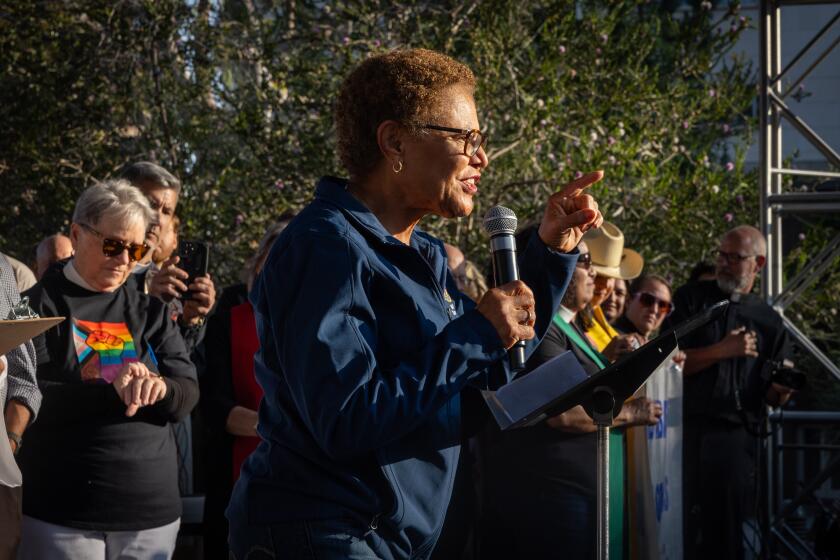A New Chapter
- Share via
Finding a library open in most of Ventura County used to demand tactics akin to securing a reservation at a popular Beverly Hills restaurant: persistence, flexibility and the realization that prime weekend times were definitely out.
But two months after library hours increased in four of the county’s largest cities, that is changing.
With libraries open five days a week in Moorpark, six days in Ventura and seven days in Simi Valley and Camarillo, patrons can actually go to a library on a whim.
That’s what happened last Monday afternoon to Ventura resident Robert Castellanos, 30, and his 3-year-old daughter, Katie, when the pair dropped by the downtown E.P. Foster Library and found it open.
“I hope it stays this way,” said Castellanos, adding he was surprised the library wasn’t closed. “Access is more convenient. . . . Before, it seems like I took my chances.”
Castellanos conceded that he rarely uses the library because of what he found to be limited and haphazard hours. But he said he is more likely to visit his neighborhood library now that he knows it is open more often.
Indeed, in a sign the system’s 400,000 patrons may already be taking advantage of the longer hours, book circulation increased more than 11% in September over the same month the previous year.
But expanded hours cannot solve all the library system’s problems, advocates acknowledge. Patrons coming to the library more often will eventually realize that the branches need more money to spend on books, computers and other services.
As if to illustrate that point, Castellanos was unsuccessful in finding the car-repair manual he sought.
But county officials see the increased hours as a key first step.
“Our goal is to make the library more responsive to citizens and cities,” said Alan Langville, community libraries division manager. “These changes are necessary. They have to be done or we wouldn’t be able to survive.”
The longer hours in many communities served by the county’s Library Services Agency came about with a revamped budget that puts more money into the local branches and less into administration.
The agency’s $5.1-million budget--about half what it was five years ago--is spread across the local communities except Thousand Oaks, Oxnard and Santa Paula, which operate their own library systems.
A reorganization will lead to an anticipated 20% cut in administration and other central-service reductions such as book ordering, Langville said. The savings, including staff layoffs, will result in more than two-thirds of the budget being funneled directly to branches and, in theory, to better service for the patrons.
The philosophy means a greater emphasis on meeting users’ needs by tapping other resources:
* Grant money is providing the cash for expanded children’s programs, more hours at smaller branches and personal computers that will link all libraries with the Internet by the end of January.
* Volunteer hours have jumped 25% in the last year alone, as 300 more volunteers help run expanded programs and staff libraries that are now open longer.
In addition, the reorganization plan calls for directing property-tax money back to the city it came from. That means more money and a subsequent boost in library hours in the larger cities.
Moreover, a new commission is being established to give each city more of an investment in the library system.
On Tuesday, Ojai became the first to endorse the idea of the eight-member commission, and other city councils are expected to follow suit this month.
George Berg, spokesman for Save Our Libraries--a group formed in 1995 to push for voter approval of taxes to pay for libraries in Ojai and Ventura, cautions against considering the change in priorities a triumph.
“It would be misleading to assume we’re now going to have good libraries just because the libraries are open more hours,” he said. “I don’t think anybody should mistake the problem as simply excess administration. And they shouldn’t mistake this as a solution.”
Inherent problems remain, said officials and critics.
Reallocating tax money to the communities that generate it leaves the smaller cities with small tax bases--such as Port Hueneme and Fillmore--unable to expand library hours.
Indeed, Ojai’s library would not have opened seven days a week beginning in September 1996 either, were it not for the parcel tax voters approved in March of that year. In addition, a federal grant that has enabled libraries in such unincorporated areas as Saticoy to boost hours expires in June.
Also, the system’s government-funded book budget is essentially nonexistent, with most of the $400,000 annually spent on books coming from donations by individuals and various Friends of the Library groups. The “pathetic” budget is far below the $1.5 million that should be spent annually on library materials for the population the system serves, Langville said.
Many people are still belatedly discovering their local branches’ hours have grown. Fewer yet know why and care how that has come about.
“I’m just glad to see them open more,” said Christy Meyer, a Camarillo mother of two. “It was kind of irritating for them to always be closed.”
Simi Valley resident Gregg Butler, 47, a returning student who will graduate from Pepperdine University with a master’s in business administration later this month, has also appreciated his branch’s recent jump in hours.
Although unsure of the exact reason behind the move, Butler applauded it.
“I think they probably got a lot of complaints and had to come up with a budget,” he said, adding he has noticed an attitude change among employees as well. “It seems to me the staff is much more committed. . . . They seem to understand more about who their customer is and how to serve.”
Still, Berg predicts that as library patrons begin to use their branches more, the system’s shortcomings will become readily apparent.
On only the second day a grant-funded homework center opened in the Meiner’s Oaks library last month to help schoolchildren with their studies, an eighth-grader attempted to find a chemistry book to complete an assignment on a particular element, Berg said. It turned out that the lone chemistry book the library had was on the chemistry of cooking.
Berg envisions that as more people are exposed to libraries--book circulation increased almost 20% after Ojai’s library hours increased--they may be more inclined to insist that more money be found to improve services and enhance book selection.
But that doesn’t necessarily follow.
Meyer said she would support higher taxes devoted to schools, but not libraries.
“There’s tons of libraries around here for you to go to,” she said. “If you can’t find what you want in one, just go to another. . . . If anything, they should increase the libraries at the schools so kids wouldn’t have to go to public libraries.”
In the long run, Berg hopes such attitudes evolve.
Grants that support programs run out and the public’s expectations of an institution they visit more often will rise, Berg believes.
“A barely adequate library with its doors open is more use to the public than a somewhat more adequate library that is never open,” he said.
“I would like to see people being able to use the libraries now to realize what more needs to be done, so that in another year or so all of the cities and the county libraries will find additional sustained sources of money.”
More to Read
Sign up for Essential California
The most important California stories and recommendations in your inbox every morning.
You may occasionally receive promotional content from the Los Angeles Times.













